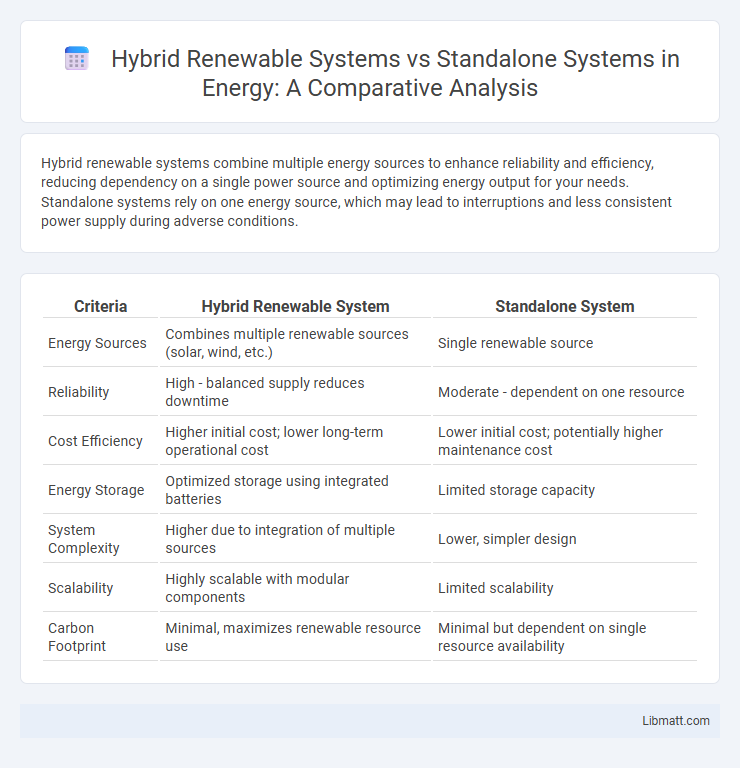Hybrid renewable systems combine multiple energy sources to enhance reliability and efficiency, reducing dependency on a single power source and optimizing energy output for your needs. Standalone systems rely on one energy source, which may lead to interruptions and less consistent power supply during adverse conditions.
Table of Comparison
| Criteria | Hybrid Renewable System | Standalone System |
|---|---|---|
| Energy Sources | Combines multiple renewable sources (solar, wind, etc.) | Single renewable source |
| Reliability | High - balanced supply reduces downtime | Moderate - dependent on one resource |
| Cost Efficiency | Higher initial cost; lower long-term operational cost | Lower initial cost; potentially higher maintenance cost |
| Energy Storage | Optimized storage using integrated batteries | Limited storage capacity |
| System Complexity | Higher due to integration of multiple sources | Lower, simpler design |
| Scalability | Highly scalable with modular components | Limited scalability |
| Carbon Footprint | Minimal, maximizes renewable resource use | Minimal but dependent on single resource availability |
Introduction to Hybrid and Standalone Renewable Systems
Hybrid renewable systems integrate multiple energy sources such as solar, wind, and battery storage to maximize efficiency and reliability in power generation. Standalone renewable systems rely on a single energy source, typically solar panels or wind turbines, often requiring oversized batteries to ensure continuous power supply. Hybrid systems offer improved resilience and cost-effectiveness by balancing energy production and storage, reducing dependence on external grids compared to standalone setups.
Core Components of Hybrid vs Standalone Systems
Hybrid renewable energy systems combine multiple energy sources such as solar panels, wind turbines, and battery storage to enhance reliability and efficiency, while standalone systems typically rely on a single source like solar power paired with batteries. Core components of hybrid systems include energy management controllers, inverters compatible with diverse inputs, and hybrid charge controllers that optimize power flow from various sources. In contrast, standalone systems primarily consist of solar panels, battery banks, a charge controller, and a single inverter, limiting their adaptability and power continuity during low generation periods.
Energy Reliability and Power Supply Consistency
Hybrid renewable systems offer superior energy reliability and power supply consistency by integrating multiple energy sources, such as solar, wind, and battery storage, which compensate for the intermittent nature of individual components. Standalone systems, relying on a single source, often face fluctuations and potential outages during periods of low resource availability. Your energy needs are better secured with hybrid systems due to their ability to maintain continuous power supply despite changing environmental conditions.
Cost Comparison: Initial Investment and Long-term Savings
Hybrid renewable systems typically require higher initial investment costs due to the integration of multiple energy sources and advanced control technologies. Standalone systems have lower upfront expenses but often lead to higher operational costs and reduced efficiency over time. Long-term savings are greater with hybrid systems as they optimize energy production, reduce reliance on fossil fuels, and minimize maintenance expenses.
Environmental Impact and Sustainability
Hybrid renewable systems combine multiple energy sources, such as solar and wind, to reduce reliance on fossil fuels and lower greenhouse gas emissions, enhancing environmental sustainability. Standalone systems, while simpler, often depend on a single energy source, which can lead to intermittent power supply and less efficient resource utilization. The integration in hybrid systems maximizes energy output and promotes long-term ecological balance by minimizing carbon footprint and resource depletion.
Scalability and Future Expansion Potential
Hybrid renewable systems offer greater scalability and future expansion potential compared to standalone systems by integrating multiple energy sources, such as solar, wind, and storage, to optimize power generation and adapt to increasing energy demands. Standalone systems typically have limited capacity and flexibility, making upgrades more complex and costly when scaling up for growing energy needs. Your choice of a hybrid system ensures seamless incorporation of additional modules and technologies, enhancing efficiency and long-term sustainability.
Maintenance Requirements and Operational Complexity
Hybrid renewable systems generally require more maintenance and operational oversight due to the integration of multiple energy sources like solar, wind, and storage components, demanding regular system checks and advanced monitoring. Standalone systems, such as single-source solar panels or wind turbines, tend to have simpler maintenance routines and lower operational complexity, making them easier to manage but potentially less reliable in fluctuating conditions. Your choice between these systems should consider your capacity to manage ongoing maintenance and the technical expertise available to ensure optimal performance.
Grid Integration and Energy Storage Solutions
Hybrid renewable systems combine multiple energy sources such as solar, wind, and battery storage, enhancing grid integration by balancing supply-demand fluctuations and reducing reliance on fossil fuels. These systems incorporate advanced energy storage solutions like lithium-ion or flow batteries to store excess energy, ensuring consistent power output and enhancing grid stability. In contrast, standalone systems lack seamless grid connectivity, often requiring oversizing or dedicated storage to maintain energy reliability during variable renewable resource availability.
Applications: Residential, Commercial, and Industrial Use Cases
Hybrid renewable systems combine multiple energy sources like solar, wind, and battery storage, offering reliable power for residential, commercial, and industrial applications by ensuring continuous energy supply and reducing dependency on the grid. Standalone systems typically serve smaller-scale or remote residential needs with limited energy storage, making them less suitable for high-demand commercial or industrial operations. Your choice between hybrid and standalone systems depends on the specific energy demands and reliability requirements of the use case.
Choosing the Right System: Factors to Consider
Choosing between a hybrid renewable system and a standalone system involves evaluating factors such as energy demand, resource availability, and budget constraints. Hybrid systems combine multiple energy sources like solar, wind, and batteries to ensure continuous power supply and higher reliability, ideal for areas with variable resources. Your selection should consider system efficiency, maintenance costs, and scalability to maximize long-term sustainability and return on investment.
Hybrid renewable system vs Standalone system Infographic

 libmatt.com
libmatt.com